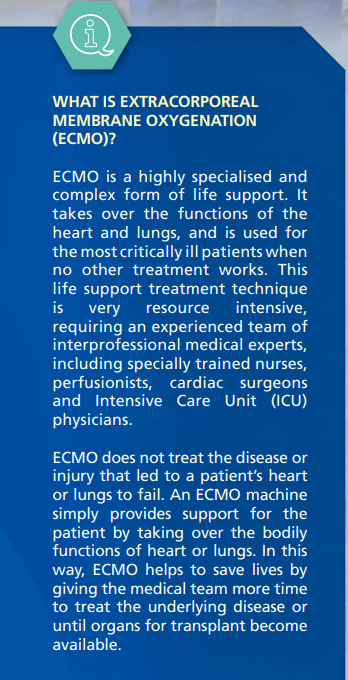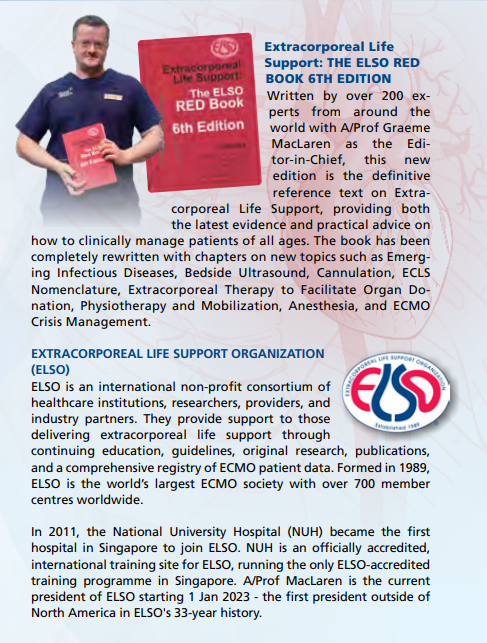Saved From Deadly Infection
ECMO: A key life-saving treatment technique
PULSE Issue 41 | July 2023
 For more than 60 days, 17-year-old
Dante Lin fought for his life relying
on the Extracorporeal Membrane
Oxygenation (ECMO) life support.
In June 2022, Mr Lin experienced
severe pain in his knee and was admitted to the National University
Hospital (NUH). Unexpectedly, his
condition rapidly deteriorated over
the next 12 hours. He fell unconscious and his oxygen levels dropped
so low that he was on the verge of a
cardiovascular collapse.
He was not responding to any treatment and was on the brink of death.
With no other viable options,
the medical team from NUHCS'
Cardiothoracic Intensive Care Unit
(CTICU) quickly put him on ECMO
to sustain his life. From then, a
multidisciplinary team comprising
healthcare professionals from both
NUHCS and NUH kept a close watch
on Mr Lin’s condition, adjusting his
treatment accordingly.
For more than 60 days, 17-year-old
Dante Lin fought for his life relying
on the Extracorporeal Membrane
Oxygenation (ECMO) life support.
In June 2022, Mr Lin experienced
severe pain in his knee and was admitted to the National University
Hospital (NUH). Unexpectedly, his
condition rapidly deteriorated over
the next 12 hours. He fell unconscious and his oxygen levels dropped
so low that he was on the verge of a
cardiovascular collapse.
He was not responding to any treatment and was on the brink of death.
With no other viable options,
the medical team from NUHCS'
Cardiothoracic Intensive Care Unit
(CTICU) quickly put him on ECMO
to sustain his life. From then, a
multidisciplinary team comprising
healthcare professionals from both
NUHCS and NUH kept a close watch
on Mr Lin’s condition, adjusting his
treatment accordingly.
“It was highly likely that Mr Lin
would have died that same night had
he not been stabilised with ECMO,”
said A/Prof Graeme MacLaren,
Director, Cardiothoracic Intensive
Care Unit (CTICU) and Senior
Consultant, Department of CTVS,
NUHCS. He was also the lead on Mr
Lin’s medical team.
Typically, patients only need ECMO
for one to two weeks. Mr Lin was
the first such patient at NUH who
depended on ECMO life support
for much longer. In total, he spent
62 days on ECMO and 98 days in
the CTICU.
While in CTICU, he had good days
and bad, experiencing multiple
life-threatening situations. At one
point, the medical team had to
put him on three different types of
ECMO as no air could go in or out of
his lungs.
For two whole months, Mr Lin remained unconscious while the ECMO
machine took over the bodily functions of his heart and lungs. Connected to the equipment by a number of
tubes, wires and cables, his medical
team monitored his condition closely, frequently adjusting the amount
of support he required.
Eventually, he woke up and slowly regained his strength, weaning
off the ECMO life support in stages. His heart and lungs managed to
stabilise, and he could finally return
home on 26 Sep 2022.
Doctors discovered that Mr Lin’s
knee pain had been triggered by a
bacteria, “golden staph”, infection.
The bacteria entered his bloodstream and spread quickly to his
lungs, which later induced a severe
septic shock.
Septic shock is a life-threatening
condition when blood pressure
falls to dangerously low levels
during an infection. The use of
ECMO in septic shock cases is extremely rare, even in the world’s
busiest ECMO centres.
Nonetheless, Mr Dante Lin had
survived his ordeal against all odds.
A/Prof MacLaren said, “ECMO is
essentially a heroic form of life
support, used only for the sickest
patients in whom no other treatment
has worked and without which
they would otherwise die. ECMO
use is increasing worldwide, in part
because of the COVID-19 pandemic,
but also because clinicians are
becoming more skilled at using it.”

